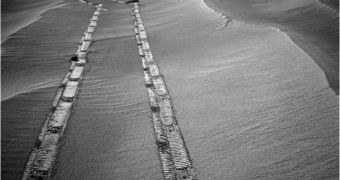Scientists at NASA announce that today will be a momentous occasion for the team of investigators managing the Mars Exploration Rover (MER) program. On May 20, Opportunity will exceed the surface longevity record that the Viking 1 Lander set a long time, after having spent more than 6 years and 116 days on the Red Planet. Scientists at the NASA Jet Propulsion Laboratory (JPL) in Pasadena, California, who manage the MER mission, say they are ecstatic about the fact that this mission, which was originally scheduled to last for only three months, managed to get this far.
Though Opportunity currently holds the official record, it is not the longest-lived human spacecraft on Mars. Its twin, Spirit, arrived on the planet three weeks before it did. However, at this point, experts cannot establish communications with the robot. The geology explorer is located at a latitude where it does not get enough power during the winter months. As such, it needs to enter a safe mode, where only the most critical components are maintained operational. If and when Spirit sends another communication, NASA officials will officially bestow this record to its rightful owner.
“Opportunity, and likely Spirit, surpassing the Viking Lander 1 longevity record is truly remarkable, considering these rovers were designed for only a 90-day mission on the surface of Mars. Passing the solstice means we're over the hump for the cold, dark, winter season,” explains the JPL MER mission manager, John Callas. The solstice of the fourth winter Spirit has to endure on Mars took place on May 13 (UTC), the scientist adds. Due to the nature of Martian climate during the winter month, scientists hope that the stuck rover will generate sufficient power from its solar panels to endure.
Speaking about the rocks, minerals and sediments that Opportunity seeks to find at its next-planned destination, the principal scientist of the mission, Cornell University expert Steve Squyres, said, “Those minerals form under wet conditions more neutral than the wet, acidic environment that formed the sulfates we've found with Opportunity. The clay minerals at Endeavour [Crater] speak to a time when the chemistry was much friendlier to life than the environments that formed the minerals Opportunity has seen so far. We want to get there to learn their context. Was there flowing water? Were there Steam vents? Hot springs? We want to find out.”
Unlike Spirit, Opportunity is not located at a latitude requiring it to shut down for winter, in order to conserve energy. That is to say, it can roam around for as log as it wants. The robot has traveled for more than 20 kilometers thus far, but JPL mission managers plan to drive it for at least an additional 8 miles. The goal is Endeavour Crater, which orbital images reveal contains interesting rocks that the rover could analyze.

 14 DAY TRIAL //
14 DAY TRIAL //